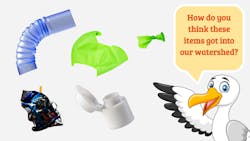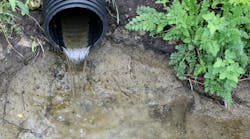Webinars Make Waves in Community Outreach and Permit Compliance Programs
As the COVID-19 pandemic kicked into high gear in March 2020, many local stormwater agencies had already rolled out their schedules of community outreach events to address watershed pollution and protection for the year ahead. But social-distancing requirements made holding those events nearly impossible. Agencies in California immediately got to work and transformed National Pollutant Discharge Elimination System (NPDES)-required community education programs from in-person events to online webinars. Unexpectedly, agencies like the San Mateo Countywide Water Pollution Prevention Program found the new format can be even more engaging and successful than traditional in-person events. At first, many agencies felt uneasy as they explored this new frontier. But all they needed was a guide.
For Reid Bogert, Stormwater Program Specialist for San Mateo County and his team, their guide was SGA Marketing, a California agency with over 20 years of experience working on stormwater public education for clients including Los Angeles City, Riverside County, and the Bay Area Stormwater Association. Its mission is to build better communities through client partnerships using marketing, communications, and research.
In May 2020, San Mateo County had an in-person event planned which typically attracts 20 to 30 attendees. With a ban on indoor gatherings still in place, they had to shift their strategy. They worked with SGA to pivot the event to an online Zoom webinar. This format not only solved the social distancing issue, it also enabled them to achieve an almost 5- to 7-fold increase in attendees (a total of 143 participants), with over 352 registrants. According to Bogert, “We heard from our participant survey that over 90% of the participants who responded to the survey found the event useful and would attend a future online webinar.”
Pivoting from an in-person event to a webinar presents challenges as well as opportunities. “Unlike traditional workshops with one presenter, webinars require two people to ensure an organized and productive event," said Suzi Senna, a project manager at SGA Marketing who managed planning and execution of several webinars for San Mateo County’s Water Pollution Prevention Program. "We find that with two presenters, one person can focus on presenting the content and the second person can initiate and monitor social interaction with participants, such as facilitating polls or quizzes that keep the audience engaged.” For Senna, an important element of a successful webinar "is for folks to chime in and engage. Sharing knowledge and creating a dialog with webinar participants is what you want to achieve.”
The ‘Webinar’ plan also allows you to directly link the registration component with an event survey, which streamlines critical webinar follow-up. SGA highly recommends sending surveys to participants during event follow-up, and using them in two ways. “You can use a survey to determine and measure participant satisfaction, as well gain insights that will help you develop messaging, content and future webinar topics,” said Senna. She explained that in San Mateo County’s follow-up surveys they often ask, “What is your barrier to (the subject of your webinar).” This answer often provides messaging insights, like “They’re too expensive," or “I don’t know if rain barrels are right for me,” which you can incorporate into your future presentations, Google search ads or promotional materials. Senna also recommends using the Zoom ‘Webinar’ plan to directly email the presentation to the registration and attendee list after the event as yet another touch-point.
Senna also advises clients to keep tweaking their ad search terms throughout the process to determine how attendees are most efficiently finding their event on the web. You can further refine the results according to demographics like geographic region and education level. However, she also advises not to begin promotion efforts until two weeks prior to the webinar. “Any earlier and your event loses momentum in the online world.”
Bogert, Senna, and the team have organized and hosted several virtual events since the first online rain barrel workshop, with equal success. “We’re happy to see it was not just a one-hit-wonder. It seems there’s a big appetite for virtual events under the current conditions. We plan to continue leveraging the virtual space for the foreseeable future, even after the pandemic is over,” said Bogert. Future stormwater outreach topics include a new rain garden incentive program and sustainable gardening.
Bogert was surprised how easily and efficiently community-building happened after their first online webinar. “We asked participants whether they would consider installing a rain barrel after attending the event, to which 68% [said they] planned to do so in the next 12 months," he said. "We keep track of rain barrel installations over time via a web-based map on our outreach website. San Mateo County witnessed a significant uptick in people adding their rain barrel projects to the map in the timeframe after the rain barrel workshop in May.”
Another aspect of hosting a successful webinar is knowing your audience. For SGA project manager Angie Lee, this was especially important when working with the Riverside County Watershed Protection Program in Southern California.
“A computer screen is like a TV screen,” said Lee, “So for the webinar we also added an element of children’s TV programming by creating a puppet version of Sunny the Seagull and using it intermittently to ask students questions and keep them engaged.” Video content was also replaced with moving images and simple animations to keep things running smoothly and prevent technical glitches due to students’ varying internet speeds.
In three short months and while facing the COVID-19 pandemic, the Riverside County Watershed Protection Public Outreach Program, guided by Lee and the SGA team, successfully reached a total of 2,840 students at 16 schools, spanning three watersheds. One hundred percent of the teachers evaluated believed the presentation had a clear take-home message and 87% expressed that they would recommend the program to others.
Julie Mulzoff is a copywriter and communications consultant with Verbatim Strategies, a firm she founded in 2008. Prior, she served for several years as the National Media Relations Manager for the USA branch of YMCA.
About the Author
Julie Mulzoff
Julie Mulzoff is a copywriter and communications consultant with Verbatim Strategies, a firm she founded in 2008. Prior, she served for several years as the National Media Relations Manager for the USA branch of YMCA.






